EMD "E8" Locomotives: Specs, Roster, History
Last revised: February 20, 2025
By: Adam Burns
In many ways, Electro-Motive's E8 was the builder's pinnacle passenger locomotive; it saw nearly as many sales as the earlier E7, boasted several upgrades, and was a very common sight leading both well-known, and relatively obscure, trains until the start of Amtrak.
The 1950s was the last great decade of privately operated passenger trains; rising costs, growing competition from other transportation modes, and a national recession in 1958 saw most railroads greatly curtail investment.
In fact, some lines were already slashing schedules before 1960. The Southern Pacific was one such example. In his book, "Southern Pacific Railroad," Brian Solomon notes the SP, once lauded for its many fine trains like the Daylights, began cutting back drastically on its services as early as 1957 in an effort to curb the growing losses from automobiles and airlines.
As a result of the public abandoning trains, Electro-Motive sold far fewer of its final "E" model, the E9, which entered the catalog in 1954. While these were the finest locomotives in the series from a mechanical and technological standpoint, EMD sold only 152 examples to a handful of railroads.
Photos
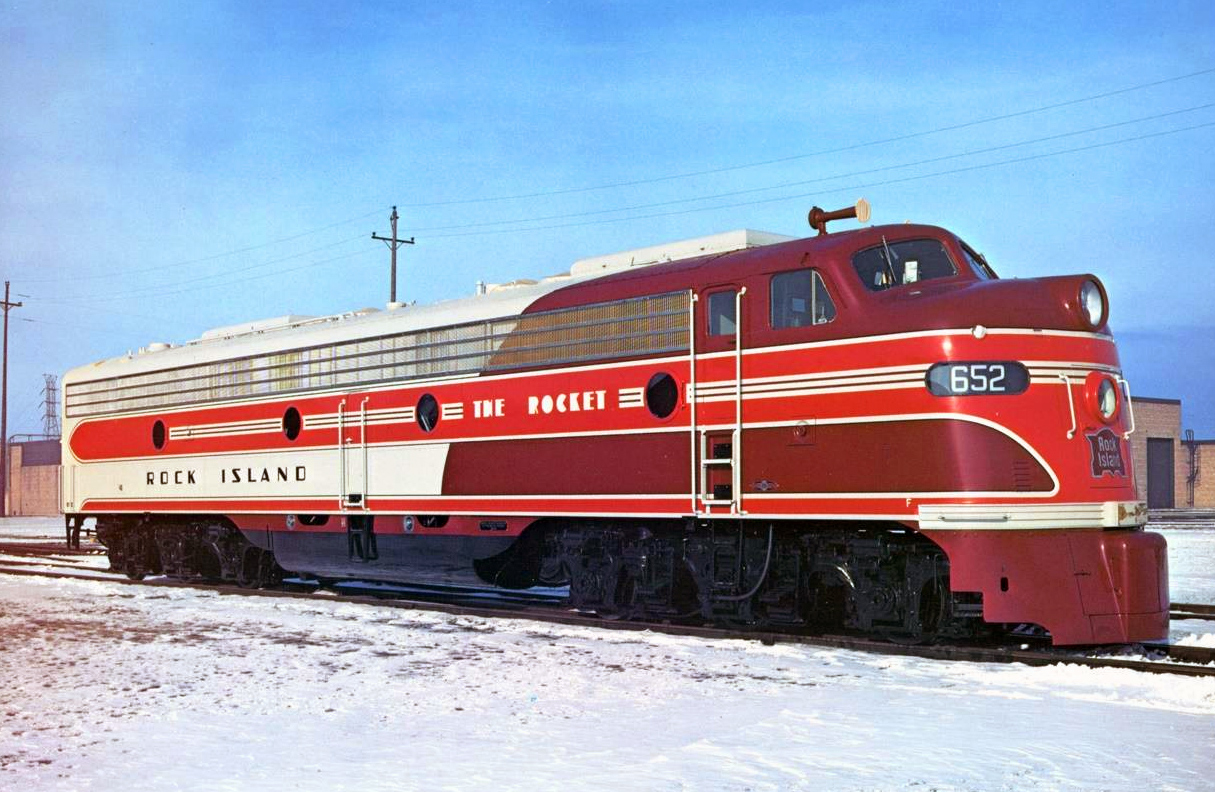 An Electro-Motive company photo of freshly outshopped Rock Island E8A #652 in early 1952. American-Rails.com collection.
An Electro-Motive company photo of freshly outshopped Rock Island E8A #652 in early 1952. American-Rails.com collection.History
The E8 began production in August, 1949 when Electro-Motive unveiled demonstrator #952, a unit that was later purchased by the Rock Island as #643. It featured numerous enhancements over its earlier counterpart, the E7.
In his book, "Electro-Motive: E Units And F Units," author Brian Solomon notes these included AC motor-operated applications which eliminated belt-driven exhaust fans, dual steam generators (or a single, large steam generator) for greater steam heating, upgraded (and more rugged) D27 traction motors, slightly more horsepower (2,250 hp), and EMD's first A1A-A1A locomotive offered with dynamic braking.
The new traction motors allowed the E8 to produce greater tractive effort at lower speeds and improved short-time ratings while the AC motors were more reliable and provided greater cooling capacity. The D27s were also interchangeable with older traction motors, allowing them to operate in older locomotives without additional engineering, or other work, necessary to do so.
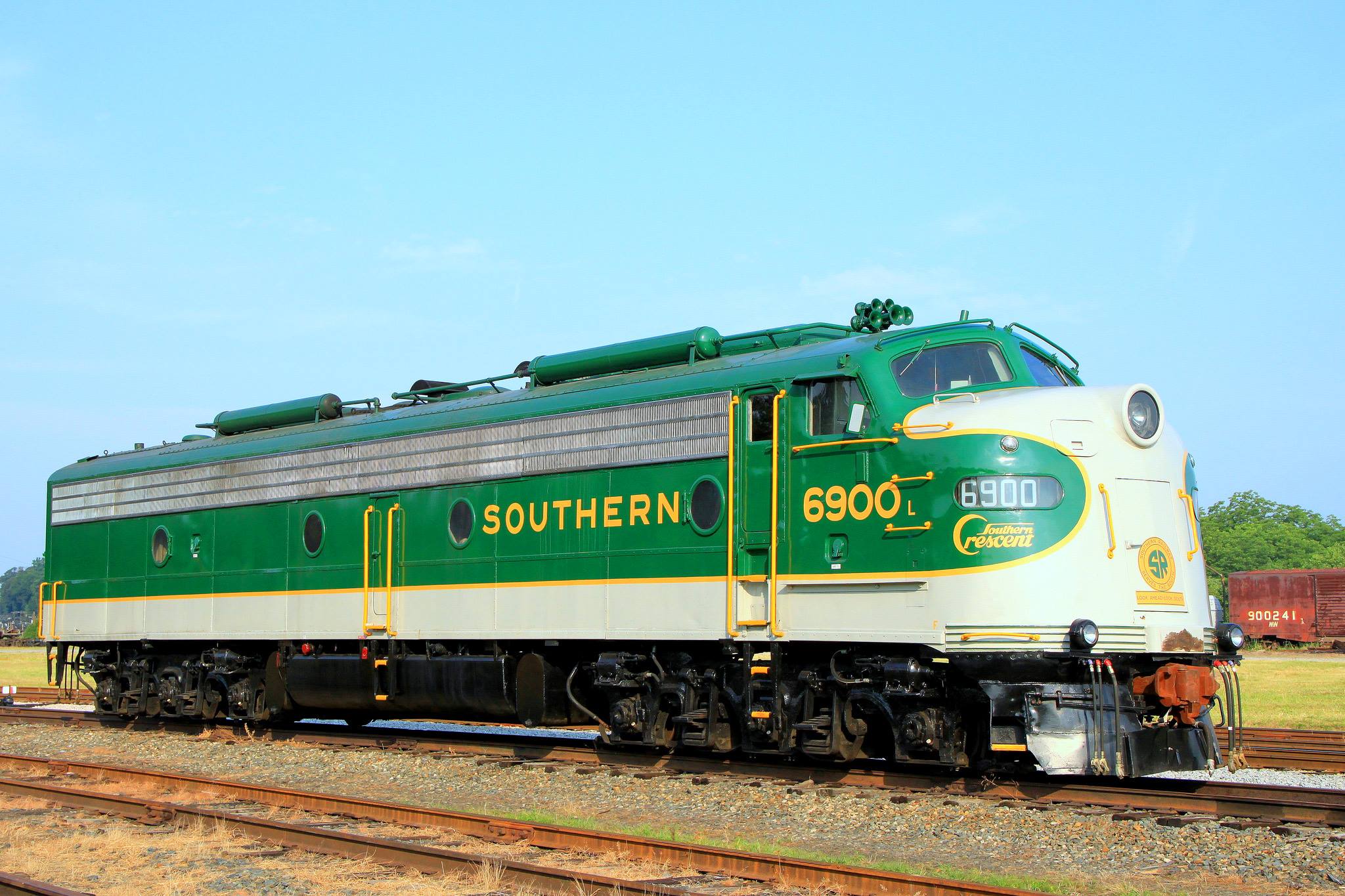 Preserved Southern Railway E8A #6900 at the North Carolina Transportation Museum in Spencer. Warren Calloway photo.
Preserved Southern Railway E8A #6900 at the North Carolina Transportation Museum in Spencer. Warren Calloway photo.All of these new features presented railroads with a locomotive that was much more reliable and easier to maintain than any previous EMD design. It was all part of the builder's efforts to improve efficiency by keeping locomotives out on the road, where they belonged, earning money.
Parts, such as traction motors, could be swapped in an out among virtually any model. This design feature is a significant reason why EMD enjoyed such incredible success from the 1940s until the early 1980s.
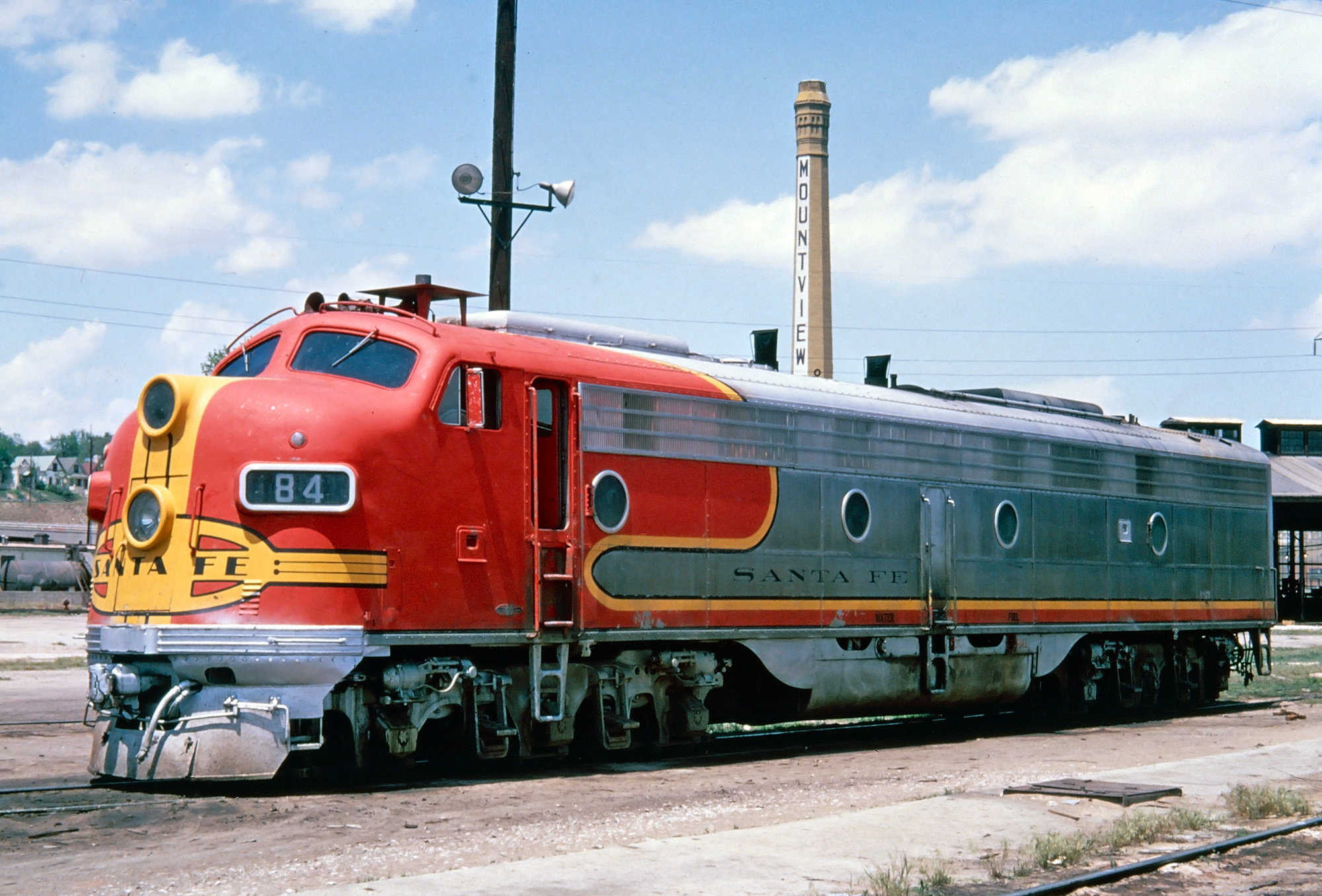 Santa Fe E8Am #84-L, rebuilt from E1A #6 in the spring of 1953, is seen here at Colorado & Southern's Rice Yard in Denver during the 1960s. The unit was later retired in June, 1970. American-Rails.com collection.
Santa Fe E8Am #84-L, rebuilt from E1A #6 in the spring of 1953, is seen here at Colorado & Southern's Rice Yard in Denver during the 1960s. The unit was later retired in June, 1970. American-Rails.com collection.If you were a train enthusiast from the 1950s through the 1970s, you most likely saw at least one E8 in service; the model was not only in widespread use throughout the industry but as railroads cutback on passenger services, they purchased very few models dedicated solely to such trains.
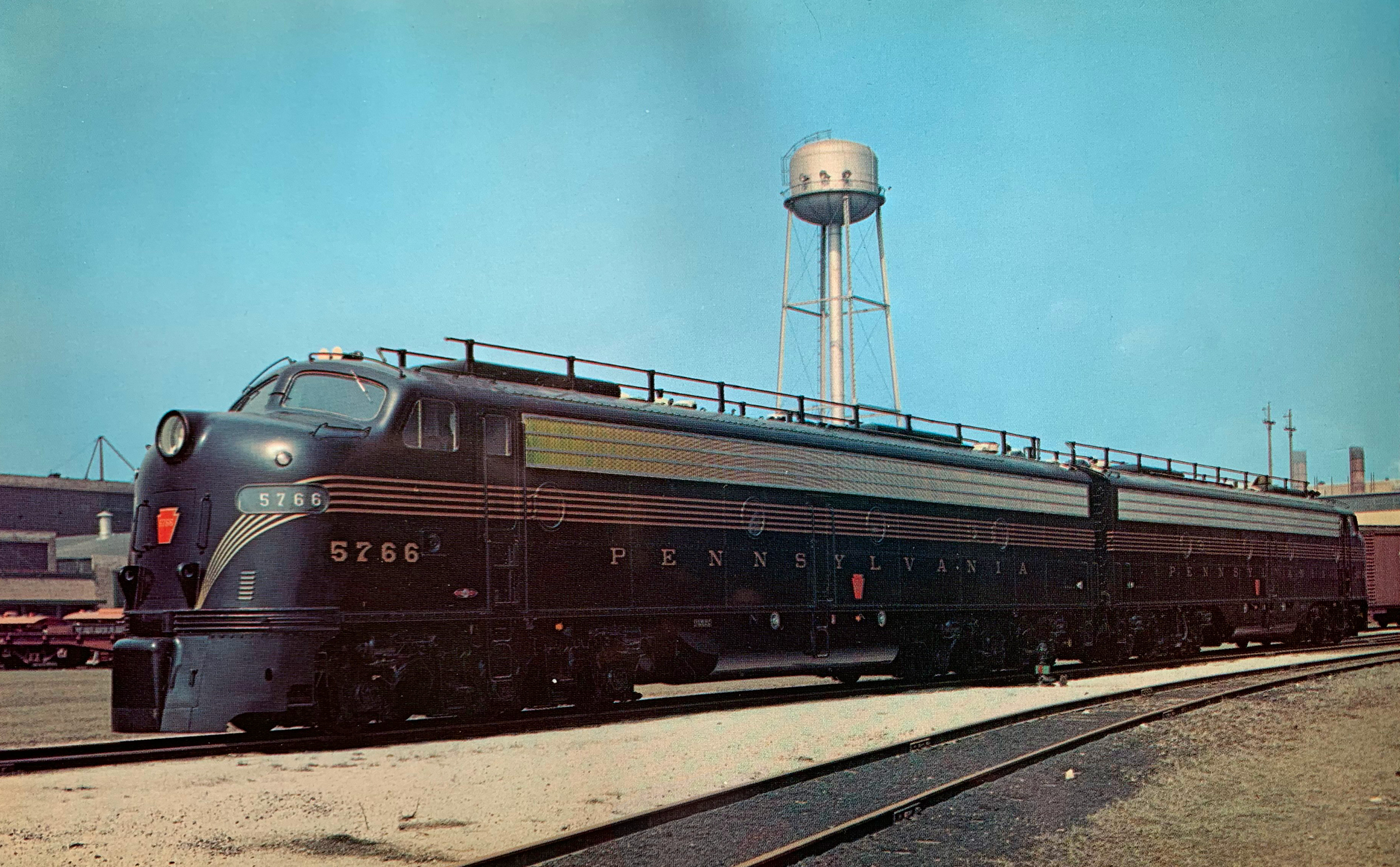 In this Electro-Motive photo, a pair of the Pennsylvania Railroad's recently completed E8A's bask in the midday sun during the spring of 1952. American-Rails.com collection.
In this Electro-Motive photo, a pair of the Pennsylvania Railroad's recently completed E8A's bask in the midday sun during the spring of 1952. American-Rails.com collection.In addition, Amtrak continued to run E8s (and E9s) for nearly a decade until new power, which had arrived in the mid-1970s by way of the SDP40Fs and F40PHs, finally displaced them.
The previously-mentioned E9 saw less than half the sales of the E8, and future models like the F45/FP45 saw only a handful of sales. In the mid/late 1960s, railroads which did purchase passenger variants tended to acquire dual-service models like the SDP40 and SDP45.
These locomotives, which were essentially road-switchers, carried no streamlining and C-C trucks, allowing them to also carry out freight assignments. Interestingly, some roads, like Erie Lackawanna, regeared their E8s for freight service after their days handling passenger trains had ended.
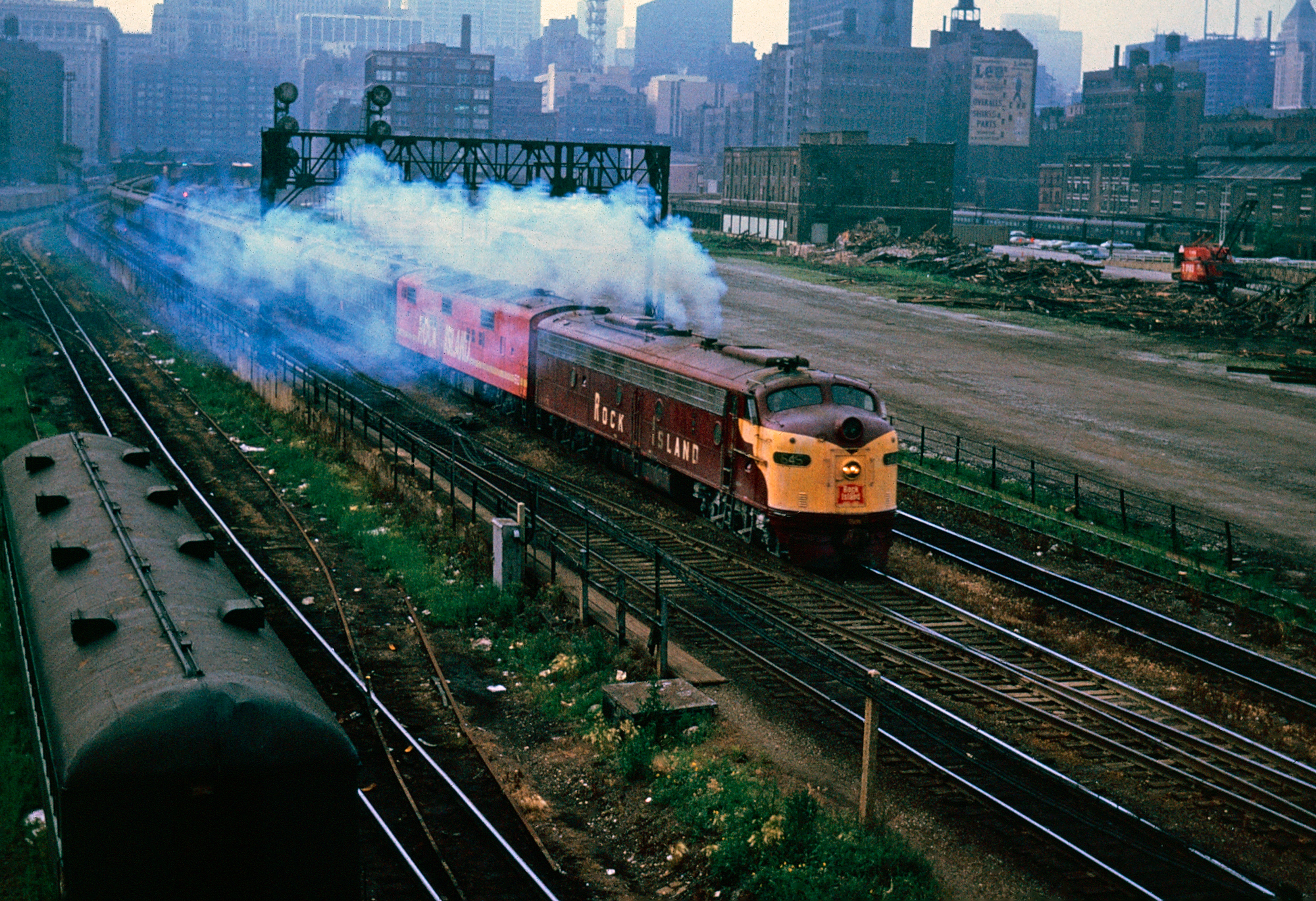 Rock Island E8A #645 and an E7B have an outbound commuter run from Chicago's LaSalle Street Station during a June evening in 1971. American-Rails.com collection.
Rock Island E8A #645 and an E7B have an outbound commuter run from Chicago's LaSalle Street Station during a June evening in 1971. American-Rails.com collection.Spotting Features
The easiest way to denote an E8 from any earlier E model is by the grilles. All other versions (EA through E7) sported rectangular, "chicken wire" air-intake grilles whereas the E8 was the first to feature a seamless, stainless-steel filter grille running the length of the carbody.
Other notable spotting features include flush number-boards, built directly into the carbody, and four evenly-spaced portholes in place of raised number-boards and rectangular/square windows along the locomotive's periphery.
Data Sheet and Specifications
| Entered Production | 8/1949 (Demonstrator #952) |
| Years Produced | 8/1949 - 12/1953 |
| Engine | 567B (2) |
| Engine Builder | GM |
| Horsepower | 2250 |
| RPM | 800 |
| Cylinders | 12 |
| Length (E8A) | 70' 3" |
| Length (E8B) | 70' 0" |
| Height (Top Of Rail To Top Of Cab) | 14' 10 ½" (E8A) |
| Height (Top Of Rail To Top Of Cab) | 14' 7 ½" (E8B) |
| Width | 10' 7 ½" |
| Weight | 316,500 Lbs (A Units): 308,300 Lbs (B Units) |
| Fuel Capacity | 1,200 Gallons |
| Air Compressor | Gardner-Denver |
| Air Compressor Model | WXO |
| Air Brake Manufacturer | Westinghouse |
| Air Brake Schedule | 24RL |
| Trucks | A1A |
| Truck Type | Blomberg |
| Truck Wheelbase | 14' 1" |
| Wheel Size | 36" |
| Steam Generator Manufacturer | Vapor-Clarkson |
| Steam Generator Capacity | 1200 Lbs/Hr |
| Traction Motors | D27/D27B (4), GM |
| MU (Multiple-Unit) | Yes |
| Dynamic Brakes | Yes (A Units) |
| Gear Ratio | 52:25, 55:21, 56:21, 57:20 |
| Tractive Effort (Starting) | 56,500 Lbs at 25% |
| Tractive Effort (Continuous) | 19,500 (52:25); 23,500 (55:21); 25,000 (56:21); 27,000 Lbs (57:20) |
| Top Speed | 117 mph (52:25), 98 mph (55:21), 92 mph (56:21), 85 mph (57:20) |
 A sharp Norfolk & Western E8A, #3800 (ex-Wabash #1000) lays over at the Decatur Shops on an October night in 1966. James D. Bopp photo, Rick Burn collection.
A sharp Norfolk & Western E8A, #3800 (ex-Wabash #1000) lays over at the Decatur Shops on an October night in 1966. James D. Bopp photo, Rick Burn collection.Production Roster
E8A
Total Built = 426
| Owner | Road Number | Serial Number | Order Number | Completion Date |
|---|---|---|---|---|
| Wabash | 1003-1008 | 7812-7817 | 2001 | 11/1949 |
| Central of Georgia | 811 | 8527 | 2003 | 8/1950 |
| Canadian Pacific | 1800-1802 | 8680-8682 | 2005 | 12/1949 |
| Missouri Pacific | 7018-7021 | 8635-8638 | 2006 | 6/1950 |
| Boston & Maine | 3821 | 9088 | 2008 | 1/1950 |
| Atlantic Coast Line | 544-548 | 9182-9186 | 2009 | 1/1950 |
| Southern Pacific | 6018 | 9317 | 2010 | 1/1950 |
| Richmond, Fredericksburg & Potomac | 1001-1005 | 9528-9532 | 2011 | 11/1949 |
| Chicago, Burlington & Quincy | 9937B, 9938A-9945A, 9938B-9945B, 9946A | 9674-9691 | 2012 | 12/1949 - 5/1950 |
| Chicago, Burlington & Quincy | 9946B | 10031 | 2012 | 5/1950 |
| St Louis-San Francisco Railway (Frisco) | 2006-2015 | 10172-10181 | 2014 | 2/1950 |
| Baltimore & Ohio | 90, 90A, 92, 92A | 10231-10234 | 2015 | 9/1950 |
| Electro-Motive (Demonstrator) | 952 (became Rock Island 643) | 10306 | E952 | 8/1949 |
| Pennsylvania | 5884A-5893A | 10421-10430 | 6079 | 3/1950 - 4/1950 |
| St Louis-San Francisco Railway (Frisco) | 2016-2017 | 10451-10452 | 2014 | 5/1950 |
| St Louis-San Francisco Railway (Frisco) | 2018-2019 | 10528-10529 | 2014 | 5/1950 - 6/1950 |
| Union Pacific | 926-930 | 10777-10781 | 2019 | 5/1950 - 8/1950 |
| Missouri-Kansas-Texas (Katy) | 106A, 106B - 107A, 107B | 11223-11226 | 6082 | 3/1950 |
| Chicago & North Western | 5021A, 5021B - 5022A, 5022B | 11491-11494 | 6095 | 7/1950 |
| Texas & Pacific (Missouri Pacific) | 2014-2017 | 11584-11587 | 6104 | 10/1951 - 11/1951 |
| Illinois Central | 4018-4021 | 11633-11636 | 2021 | 6/1950 |
| Central of Georgia | 812 | 11700 | 2003 | 8/1950 |
| Chicago, Burlington & Quincy | 9947A, 9947B - 9948A, 9947B | 11701-11704 | 2023 | 9/1950 |
| Chicago, Burlington & Quincy | 9949A | 11762 | 2023 | 9/1950 |
| St Louis-San Francisco Railway (Frisco) | 2020-2022 | 11965-11967 | 2014 | 7/1950 |
| Erie Railroad | 820-833 | 12218-12231 | 2027 | 1/1951 - 3/1951 |
| Baltimore & Ohio | 94, 94A, 96, 96A | 12712-12715 | 6162 | 9/1950 - 10/1950 |
| Pennsylvania | 5808A-5810A, 5835A-5839A, 5894A-5899A, 5902A-5905A | 13101-13118 | 6181 | 1/1951 - 4/1951 |
| Seaboard Air Line | 3049-3054 | 13274-13279 | 6192 | 10/1950 |
| Electro-Motive (Demonstrators) | 810-811 (became Delaware, Lackawanna & Western 810-811) | 13676-13677 | Sold on 6232 | 1/1951 |
| Louisville & Nashville | 794-797 | 13830-13833 | 2036 | 5/1951 |
| Delaware, Lackawanna & Western | 812-820 | 14011-14019 | 2033 | 4/1951 - 5/1951 |
| Illinois Central | 4022-4025 | 14083-14086 | 2037 | 4/1951 |
| Southern | 2923-2926 | 14172-14175 | 2039 | 9/1951 |
| Southern | 2927-2929 | 14176-14178 | 2049 | 9/1951 - 10/1951 |
| Rock Island | 644-649 | 14276-14281 | 2032 | 6/1951 - 7/1951 |
| Missouri-Kansas-Texas (Katy) | 131-135 | 14283-14287 | 6268 | 5/1951 |
| Wabash | 1009-1011 | 14420-14422 | 6281 | 10/1951 |
| Wabash | 1012-1013 | 14423-14424 | 6282 | 6/1951 |
| New York Central | 4036-4039 | 14425-14428 | 2016 | 6/1951 |
| Texas & Pacific (Missouri Pacific) | 2010-2011 | 14548-14549 | 6104 | 8/1951 |
| Texas & Pacific (Missouri Pacific) | 2012-2013 | 14557-14558 | 6104 | 10/1951 |
| New York Central | 4040-4044 | 14583-14587 | 6291 | 8/1951 - 9/1951 |
| Chicago & North Western | 5023A, 5023B - 5024A, 5024B | 14659-14662 | 2034 | 7/1951 |
| Kansas City Southern | 26-29 | 14736-14739 | 6312 | 2/1952 |
| Chesapeake & Ohio | 4000-4026 | 14759-14785 | 2040 | 8/1951 - 1/1952 |
| Wabash | 1000 | 15063 | 6327 | 10/1951 |
| Rock Island | 650-655 | 15197-15202 | 2047 | 2/1952 - 3/1952 |
| New York Central | 4045-4053 | 15304-15312 | 6291 | 11/1951 - 3/1952 |
| New York Central | 4054-4061 | 15313-15320 | 6358 | 3/1952 - 4/1952 |
| Pennsylvania | 5765A-5769A, 5788A-5799A, 5801A-5807A | 15648-15671 | 6354 | 3/1952 - 7/1952 |
| Richmond, Fredericksburg & Potomac | 1006-1009 | 15711-15714 | 2050 | 2/1952 |
| Richmond, Fredericksburg & Potomac | 1010-1011 | 15715-15716 | 2050 | 8/1952 |
| Illinois Central | 4026-4031 | 16392-16397 | 2042 | 4/1952 - 6/1952 |
| Chicago, Burlington & Quincy | 9964-9969 | 16705-16710 | 2048 | 8/1952 - 9/1952 |
| Pennsylvania | 5700A-5716A, 5760A-5764A | 16769-16790 | 2054 | 9/1952 - 11/1952 |
| Chicago & North Western | 5025A | 16901 | 2043 | 8/1952 |
| Chicago & North Western | 5025B | 17032 | 2043 | 8/1952 |
| Seaboard Air Line | 3055-3059 | 17339-17343 | 6426 | 11/1952 - 12/1952 |
| Fort Worth & Denver (Burlington) | 9981A, 9981B | 17440-17441 | 6458 | 12/1952 |
| Wabash | 1014-1015 | 17565-17566 | 6474 | 1/1953 |
| Illinois Central | 4032-4033 | 17751-17752 | 2053 | 4/1953 |
| Union Pacific | 931-938 | 17783-17790 | 2052 | 3/1953 - 4/1953 |
| Chesapeake & Ohio | 4027-4030 | 18081-18084 | 6504 | 5/1953 |
| Chicago & North Western | 5026A, 5026B - 5030A, 5030B, 5031A | 18113-18123 | 2056 | 6/1953 |
| Richmond, Fredericksburg & Potomac | 1012-1015 | 18266-18269 | 6471 | 9/1953 - 10/1953 |
| Union Pacific | 939-942 | 18270-18273 | 2060 | 5/1953 |
| Chicago, Burlington & Quincy | 9970-9977 | 18312-18319 | 2059 | 8/1953 - 9/1953 |
| New York Central | 4062-4063 | 18345-18346 | 6515 | 5/1953 |
| New York Central | 4064-4095 | 18522-18553 | 2055 | 6/1953 - 9/1953 |
| Baltimore & Ohio | 26, 26A - 32, 32A (Evens) | 18675-18682 | 2061 | 10/1953 |
| Southern (New Orleans & North Eastern) | 6906-6915 | 19004-19013 | 2063 | 11/1953 - 12/1953 |
E8A Rebuilds
Total Built = 21
| Owner | Road Number | Serial Number | Order Number | Completion Date | Heritage |
|---|---|---|---|---|---|
| Santa Fe | 2 | 662 | 7500 | 9/1952 | E1A #2 |
| Santa Fe | 4 | 663 | 7502 | 2/1952 | E1B #2B |
| Santa Fe | 5 | 792 | 7502 | 2/1952 | E1A #5 |
| Santa Fe | 85 | 794 | 7502 | 2/1953 | E1A #7 |
| Santa Fe | 82 | 791 | 7502 | 4/1953 | E1A #3 |
| Santa Fe | 87 | 797 | 7502 | 4/1953 | E1A #9 |
| Santa Fe | 86 | 795 | 7502 | 5/1953 | E1A #8 |
| Santa Fe | 84 | 793 | 7502 | 6/1953 | E1A #6 |
| Gulf, Mobile & Ohio | 100A | 668 | 7504 | 3/1953 | ex-Baltimore & Ohio EA #52 |
| Baltimore & Ohio | 56 | 800 | 7507 | 6/1953 | EA #56 |
| Baltimore & Ohio | 55 | 767 | 7507 | 8/1953 | EA #55 |
| Baltimore & Ohio | 53 | 765 | 7507 | 10/1953 | EA #53 |
| Baltimore & Ohio | 51 | 7507 666 | 7507 | 12/1953 | EA #51 |
| Baltimore & Ohio | 54 | 766 | 7507 | 1/1954 | EA #54 |
| Kansas City Southern | 23 | 1034 | 8005 | 10/1952 | E3A #3 |
| Atlantic Coast Line | 500 | 958 | 8022 | 3/1953 | E3A #501 |
| Chicago & North Western | 5019B | 6596 | 8024 | 6/1953 | E7A #5019B |
| New York Central | 4003 | 2868 | 8025 | 6/1953 | E7A #4003 |
| New York Central | 4020 | 4175 | 8026 | 6/1953 | E7A #4020 |
| Atlantic Coast Line | 532 | 3408 | 8027 | 7/1953 | E7A #532 |
| Rock Island | 656 | 1063 | 8028 | 12/1953 | E6A #627 |
E8B
Total Built = 31
| Owner | Road Number | Serial Number | Order Number | Completion Date |
|---|---|---|---|---|
| Richmond, Fredericksburg & Potomac | 1051-1055 | 9533-9537 | 2011 | 12/1949 |
| Union Pacific | 926B-930B | 10782-10786 | 2019 | 5/1950 - 8/1950 |
| Illinois Central | 4104-4105 | 16398-16399 | 2042 | 5/1952 |
| Union Pacific | 931B-944B | 17791-17804 | 2052 | 2/1953 - 3/1953 |
| Union Pacific | 945B-949B | 18274-18278 | 2060 | 4/1953 - 5/1953 |
E8B Rebuilds
Total Built = 15
| Owner | Road Number | Serial Number | Order Number | Completion Date | Heritage |
|---|---|---|---|---|---|
| Santa Fe | 4A | 799 | 7501 | 9/1952 | E1B #4A |
| Santa Fe | 80A | 796 | 7502 | 2/1953 | E1A #4 |
| Santa Fe | 82A | 798 | 7502 | 4/1953 | E1B #3A |
| Union Pacific | 922B | 745 | 7503 | 2/1953 | E2B #SF2 |
| Union Pacific | 923B-924B | 746,742 | 7503 | 3/1953 | E2B #SF3, E2B #LA2 |
| Union Pacific | 925B | 743 | 7503 | 4/1953 | E2B #LA3 |
| Baltimore & Ohio | 51X | 667 | 7507 | 10/1953 | EB #51X |
| Baltimore & Ohio | 52X | 669 | 7507 | 5/1953 | EB #52X |
| Baltimore & Ohio | 53X | 768 | 7507 | 5/1953 | EB #53X |
| Baltimore & Ohio | 54X | 769 | 7507 | 8/1953 | EB #54X |
| Baltimore & Ohio | 55X | 770 | 7507 | 11/1953 | EB #55X |
| Baltimore & Ohio | 56X | 801 | 7507 | 1/1954 | EB #56X |
| Santa Fe | 83A | 535 | 7508 | 8/1953 | ex-Boxcab #1A |
| Santa Fe | 84A | 536 | 7508 | 9/1953 | ex-Boxcab #1B |
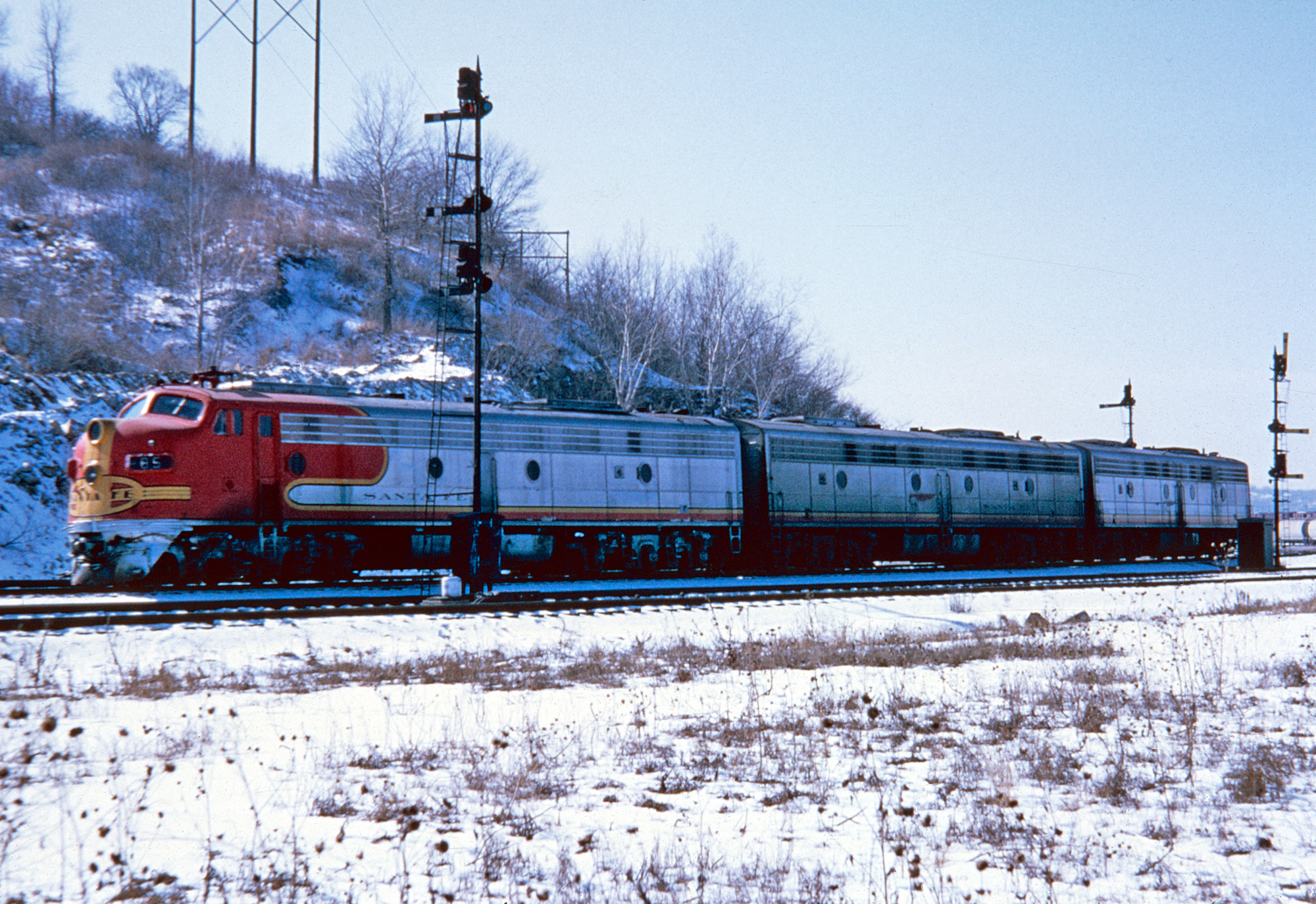 Santa Fe E8Am #85-L (rebuilt from E1A #7) and a pair of E8Bm's (also rebuilt from E1's) head east through Argentine Yard (Kansas) during the 1960s. The locomotives are about to cross Santa Fe Junction on their way to Kansas City Union Station. American-Rails.com collection.
Santa Fe E8Am #85-L (rebuilt from E1A #7) and a pair of E8Bm's (also rebuilt from E1's) head east through Argentine Yard (Kansas) during the 1960s. The locomotives are about to cross Santa Fe Junction on their way to Kansas City Union Station. American-Rails.com collection.Another notable feature was its single-stack manifold for each engine instead the four stacks per engine used on the E7. Spotting, however, can sometimes be difficult as railroads tended to rebuild and modify their E8 fleets over the years. For example, some E7s were given E8-like appearances, such as the addition of portholes.
Interestingly, there are very few visual clues that distinguish an E8 from the later E9. In his book, "Diesel Locomotives: Cyclopedia, Volume 2 (Model Railroader)," author Bob Hayden notes the only notable distinction between the two, externally, is a minor change in the headlight casing. Today, there are numerous E8A's preserved; in fact, there are more E8A's extant today than any other variant in the E series.
Sources
- Foster, Gerald. A Field Guide To Trains. New York: Houghton Mifflin, 1996.
- Hayden, Bob. Diesel Locomotives: Cyclopedia, Volume 2 (Model Railroader). Milwaukee: Kalmbach Publishing Company, 1980.
- Marre, Louis A. Diesel Locomotives: The First 50 Years, A Guide To Diesels Built Before 1972. Milwaukee: Kalmbach Publishing Company, 1995.
- Pinkepank, Jerry A. Diesel Spotter's Guide. Milwaukee: Kalmbach Publishing Company, 1967.
- Solomon, Brian. EMD Locomotives. Minneapolis: MBI Publishing Company, 2006.
- Solomon, Brian. Electro-Motive E-Units and F-Units: The Illustrated History of North America's Favorite Locomotives. Minneapolis: Voyageur Press, 2011.
Contents
Recent Articles
-
New York - Murder Mystery - Dinner Train Rides
Dec 13, 25 10:30 AM
New York State, renowned for its vibrant cities and verdant countryside, offers a plethora of activities for locals and tourists alike, including murder mystery train rides! -
Pennsylvania - Murder Mystery - Dinner Train Rides
Dec 13, 25 10:25 AM
Pennsylvania, steeped in history and industrial heritage, offers a prime setting for a unique blend of dining and drama: the murder mystery dinner train ride. -
Ohio - Murder Mystery - Dinner Train Rides
Dec 13, 25 10:14 AM
The murder mystery dinner train rides in Ohio provide an immersive experience that combines fine dining, an engaging narrative, and the beauty of Ohio's landscapes.



